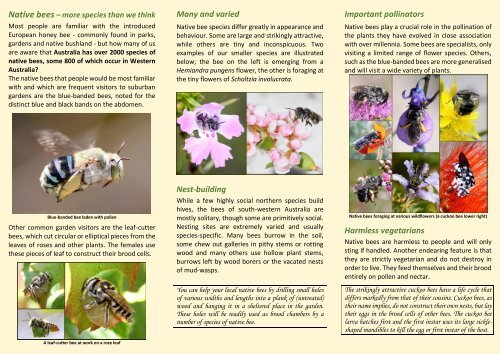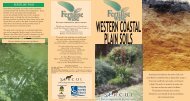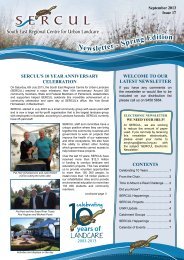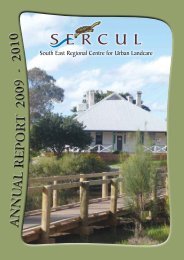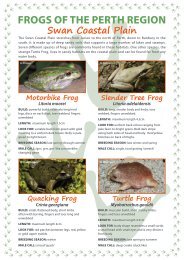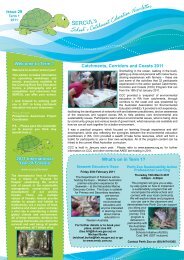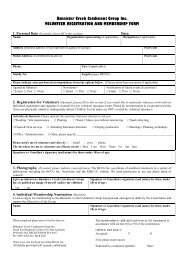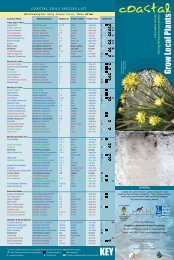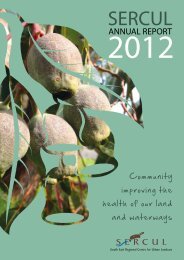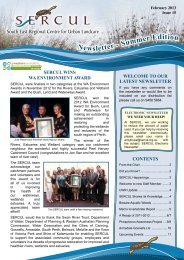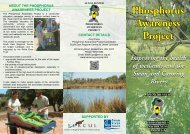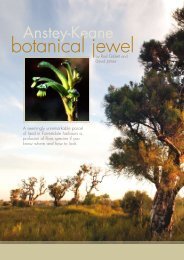Native Bees of Western Australia - SERCUL
Native Bees of Western Australia - SERCUL
Native Bees of Western Australia - SERCUL
Create successful ePaper yourself
Turn your PDF publications into a flip-book with our unique Google optimized e-Paper software.
<strong>Native</strong> bees – more species than we think<br />
Most people are familiar with the introduced<br />
European honey bee - commonly found in parks,<br />
gardens and native bushland - but how many <strong>of</strong> us<br />
are aware that <strong>Australia</strong> has over 2000 species <strong>of</strong><br />
native bees, some 800 <strong>of</strong> which occur in <strong>Western</strong><br />
<strong>Australia</strong><br />
The native bees that people would be most familiar<br />
with and which are frequent visitors to suburban<br />
gardens are the blue-banded bees, noted for the<br />
distinct blue and black bands on the abdomen.<br />
Many and varied<br />
<strong>Native</strong> bee species differ greatly in appearance and<br />
behaviour. Some are large and strikingly attractive,<br />
while others are tiny and inconspicuous. Two<br />
examples <strong>of</strong> our smaller species are illustrated<br />
below; the bee on the left is emerging from a<br />
Hemiandra pungens flower, the other is foraging at<br />
the tiny flowers <strong>of</strong> Scholtzia involucrata.<br />
Important pollinators<br />
<strong>Native</strong> bees play a crucial role in the pollination <strong>of</strong><br />
the plants they have evolved in close association<br />
with over millennia. Some bees are specialists, only<br />
visiting a limited range <strong>of</strong> flower species. Others,<br />
such as the blue-banded bees are more generalised<br />
and will visit a wide variety <strong>of</strong> plants.<br />
Blue-banded bee laden with pollen<br />
Other common garden visitors are the leaf-cutter<br />
bees, which cut circular or elliptical pieces from the<br />
leaves <strong>of</strong> roses and other plants. The females use<br />
these pieces <strong>of</strong> leaf to construct their brood cells.<br />
A leaf-cutter bee at work on a rose leaf<br />
Nest-building<br />
While a few highly social northern species build<br />
hives, the bees <strong>of</strong> south-western <strong>Australia</strong> are<br />
mostly solitary, though some are primitively social.<br />
Nesting sites are extremely varied and usually<br />
species-specific. Many bees burrow in the soil,<br />
some chew out galleries in pithy stems or rotting<br />
wood and many others use hollow plant stems,<br />
burrows left by wood borers or the vacated nests<br />
<strong>of</strong> mud-wasps.<br />
You can help your local native bees by drilling small holes<br />
<strong>of</strong> various widths and lengths into a plank <strong>of</strong> (untreated)<br />
wood and hanging it in a sheltered place in the garden.<br />
These holes will be readily used as brood chambers by a<br />
number <strong>of</strong> species <strong>of</strong> native bee.<br />
<strong>Native</strong> bees foraging at various wildflowers (a cuckoo bee lower right)<br />
Harmless vegetarians<br />
<strong>Native</strong> bees are harmless to people and will only<br />
sting if handled. Another endearing feature is that<br />
they are strictly vegetarian and do not destroy in<br />
order to live. They feed themselves and their brood<br />
entirely on pollen and nectar.<br />
The strikingly attractive cuckoo bees have a life cycle that<br />
differs markedly from that <strong>of</strong> their cousins. Cuckoo bees, as<br />
their name implies, do not construct their own nests, but lay<br />
their eggs in the brood cells <strong>of</strong> other bees. The cuckoo bee<br />
larva hatches first and the first instar uses its large sickleshaped<br />
mandibles to kill the egg or first instar <strong>of</strong> the host.
Megamouth Bee (Leioproctus muelleri)<br />
In December 2010, a species <strong>of</strong> native bee entirely<br />
new to science was discovered at Anstey-Keane<br />
Dampland (a nature reserve in Perth’s southeastern<br />
suburb <strong>of</strong> Forrestdale).<br />
This newly-discovered bee species Leioproctus<br />
(Ottocolletes) muelleri was nicknamed<br />
“Megamouth” because <strong>of</strong> the impressively large<br />
mandibles <strong>of</strong> its males (the male’s head is also<br />
comparatively large). Another feature that sets this<br />
species apart is the distinctive nest-guarding<br />
behaviour <strong>of</strong> the males, which frequently results in<br />
lively skirmishes at nest entrances. This behaviour<br />
is not known to occur in any other species <strong>of</strong><br />
solitary bee.<br />
Another interesting feature <strong>of</strong> this ground-nesting<br />
bee is the ability <strong>of</strong> the dormant larvae to survive<br />
inundation during winter in waterpro<strong>of</strong> brood cells.<br />
Because L. muelleri has to date been found<br />
nowhere but one small site at Anstey-Keane<br />
Dampland, it is reasonable to assume (there being<br />
no evidence to the contrary) that this species is<br />
extremely rare if not critically endangered.<br />
Protecting our native bees<br />
<strong>Native</strong> bees are an important component <strong>of</strong><br />
biodiversity: the valuable part they play in<br />
pollination helps to maintain the health and<br />
viability <strong>of</strong> natural ecosystems.<br />
It is therefore crucial that we protect our native<br />
bees, and the best way to do that is to protect the<br />
bushland in which they live. Clearing native<br />
bushland destroys not only vegetation but<br />
immeasurable numbers <strong>of</strong> animals - including<br />
native bees.<br />
Blue-banded bees: buzz-pollinating a Dianella flower (left) & foraging at<br />
Verticordia densiflora<br />
Another way we can help our native bees is by growing<br />
native plants in our gardens. Jacksonia, Dianella,<br />
Lechenaultia, Dasypogon, Regelia, Verticordia and<br />
Calytrix are just some <strong>of</strong> the many local plants favoured by<br />
these very special insects.<br />
All photographs (except the leaf-cutter bee) were taken at<br />
Anstey-Keane Dampland<br />
Forrestdale<br />
Clockwise from top left: L. muelleri pollen-laden female entering nest; male<br />
at entrance to nest burrow; male, showing large head and mandibles; two<br />
males fighting at entrance to nest burrow; female emerging from nest<br />
burrow.<br />
Text & photos by Bryony Fremlin


